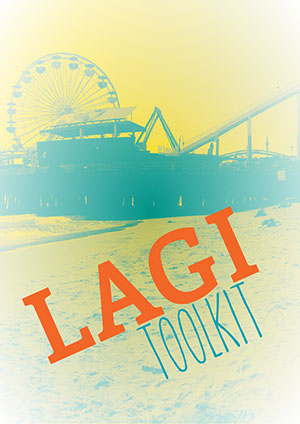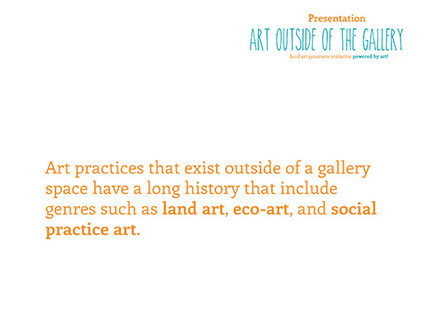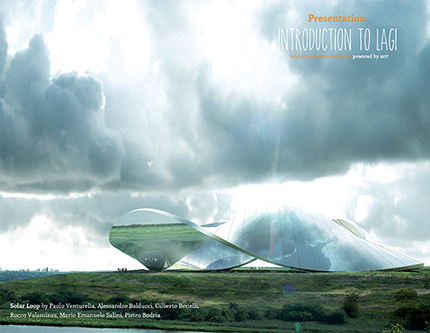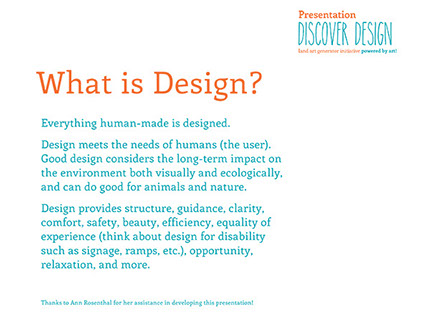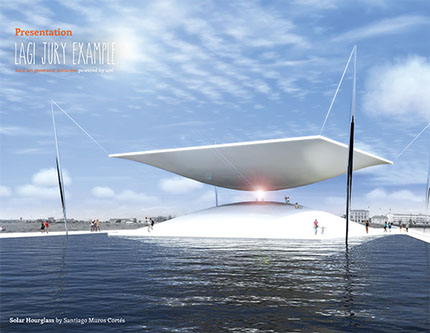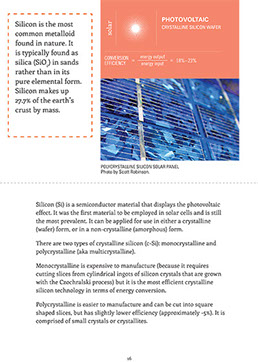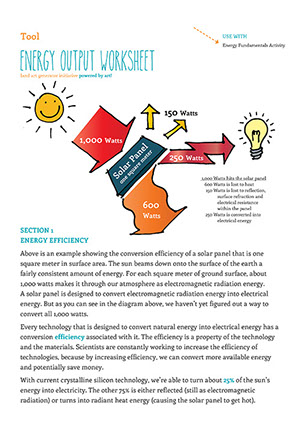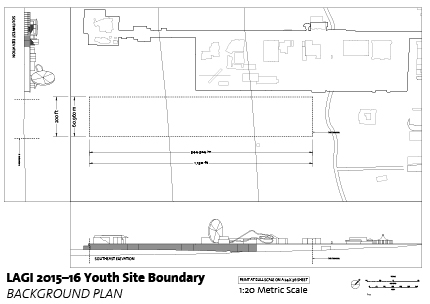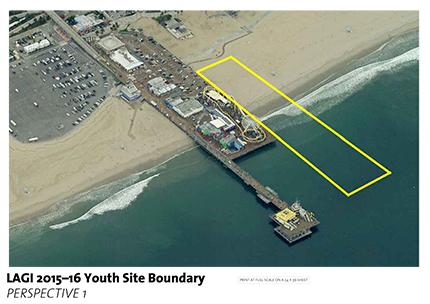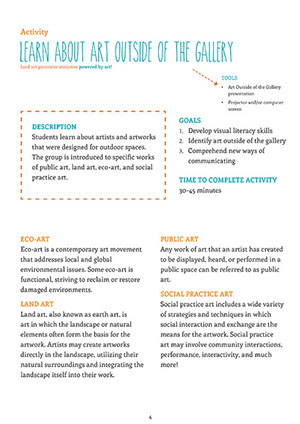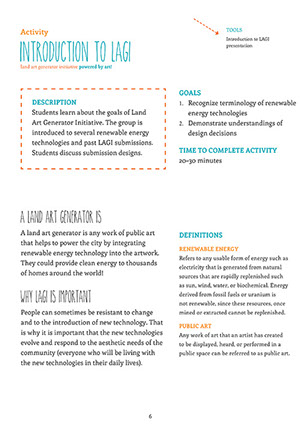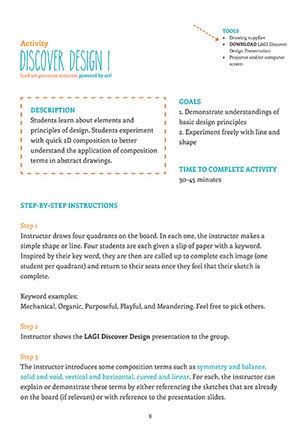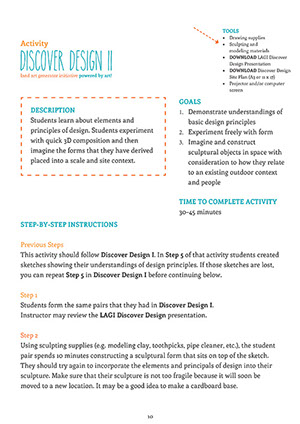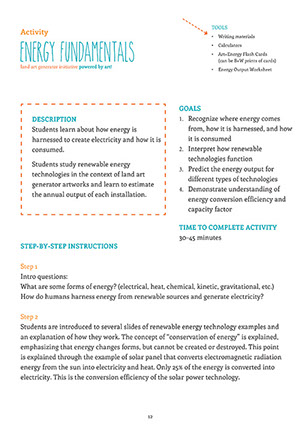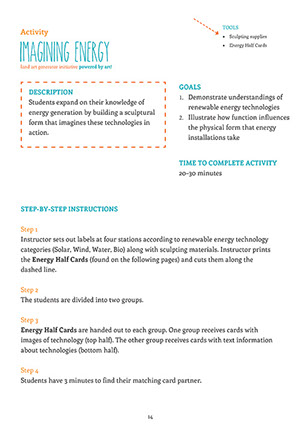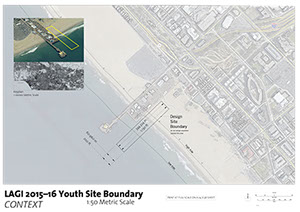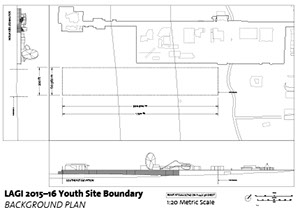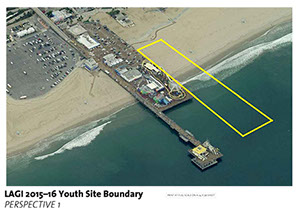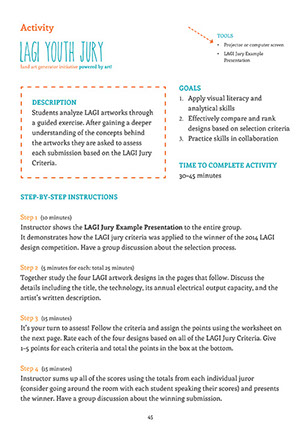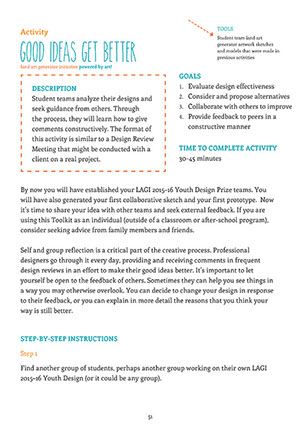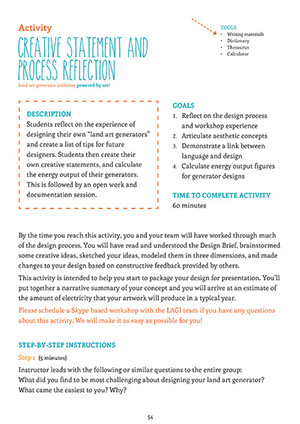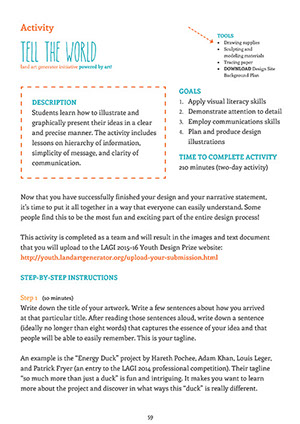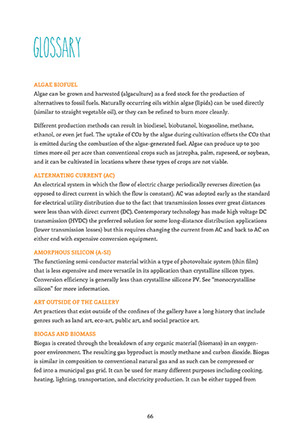TOOLKIT INTRODUCTION AND LETTER TO INNOVATORS
Dear Innovator,
Welcome to the LAGI Toolkit! These activities, presentations, and downloads are designed to work alongside the LAGI Youth Design Brief and provide classrooms and individuals with educational activities that will give you the confidence and inspiration to imagine your land art generator design and win the 2015–16 LAGI Youth Prize!
We hope it is helpful, but please note that it is not a requirement for participation in the LAGI Youth Prize.The activities in this document have been developed in collaboration with educators. We've done our best to cover many subjects in a way that is complementary and works with the flow of the design process. For the sake of brevity there are many lessons and examples that we were not able to include. The Toolkit will therefore benefit when paired with additional lessons on art, design, and energy science.
In addition to this Toolkit, we are available to help you every step of the way. Please reach out to us with any questions you may have or to schedule free workshops and presentations.
Rob and Elizabeth
lagi@landartgenerator.orgDOWNLOAD COMPLETE TOOLKIT
DOWNLOAD ALL PRESENTATIONS
DOWNLOAD THE ENERGY OUTPUT WORKSHEET
This worksheet is designed to work alongside the Energy Fundamentals Activity. It contains short lessons on energy conversion efficiency and capacity factor, the two concepts that you'll need in order to estimate the average annual output of your land art generator design. It also has some scratch space at the end for calculating the answers to the questions on the Art + Energy Flash Cards.
DOWNLOAD ALL DESIGN SITE DRAWINGS
What's the context? Where are you designing for?
The three drawings below are referenced throughout the Toolkit and provide important details and dimensions that will help you to understand the site on which your public artwork should be designed for. Each PDF contains multiple pages and gives you the option to print on large format (24x36 or A1 paper) or on smaller format (11x17 or A3 paper).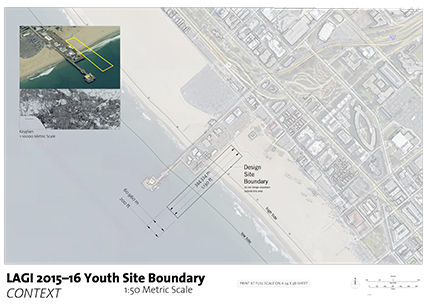
THE DESIGN PROCESS
- Understand and Comprehend the problem or challenge to be solved.
- Investigate and Explore similar problems that others have solved and Learn about the context of the problem.
- Imagine your Ideas for how the challenge can be met.
- Create sketches and models that illustrate your Plan.
- Test and Try your idea to learn if and how it works.
- Ask yourself and others what could make it better.
- Improve on your idea based on what you’ve learned. (repeat steps 3–6 a number of times)
- Present your Solution to the problem in a way that others can easily understand.
A FIELD GUIDE TO RENEWABLE ENERGY TECHNOLOGIES
Before you get to designing your energy-generating public artwork for the Santa Monica Beach, you'll probably want to get familiar with all of the technologies that exist to convert natural energies (like the sun, the wind, the waves, the tides, and natural sugars) into kilowatt-hours of electricity.
This free pdf download will give you a comprehensive survey of what is possible! As you read through the Field Guide, think about what sorts of creative applications each of the technologies could be used for. How could the function of each technology be celebrated in a way that is visually engaging to people?
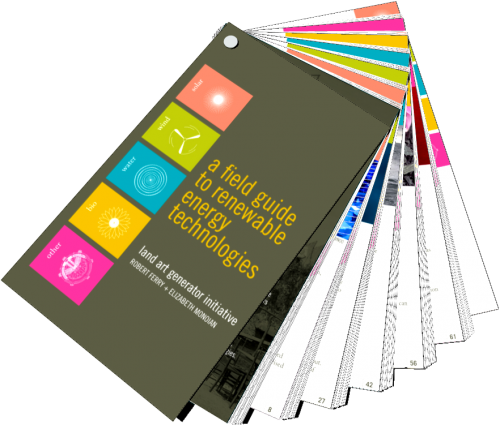
ART+ENERGY FLASH CARDS
The Land Art Generator Initiative Art + Energy Flash Cards are designed to strengthen the pragmatic problem solving skills needed to address solutions for 21st century energy challenges by offering an engaging tool for science education. They highlight real world applications of STEAM (science, technology, engineering, art, and math) objectives and teach about the importance of sustainability in design.
Science, technology, engineering, design, and art all come together in this kit. The images on the front of each card represent ideas for large-scale works of public art that generate utility-scale clean electricity for cities. These artful power plants are designed to be safe to the natural environment, not create pollution, to generate energy for up to thousands of homes, and to make our public spaces more enjoyable.
Some of them have the added benefit of edible gardens, habitats for animals, air filtration, data visualization, and areas for human recreation. Any number of different technologies and materials can be incorporated into land art generators. And each employs a variety of methods for harvesting energy from natural resources such as the sun, the wind, biochemistry, and kinetic movement.
Using land art generator proposals from the 2010, 2012, and 2014 LAGI design competitions, the cards will take you through the process of estimating the amount of electricity that each artwork is capable of generating in one year based on a number of criteria, such as the nameplate capacity of the technologies employed and the capacity factor of the installation itself (a product of site conditions and type of technology).
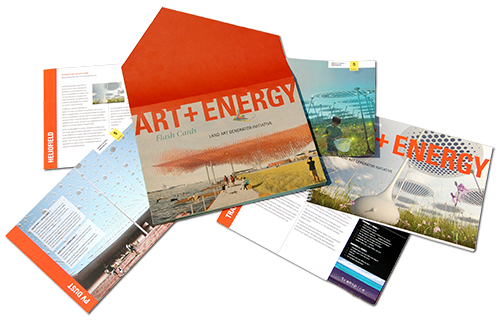
ACTIVITY: Learn about Art Outside of the Gallery + PRESENTATION: Art Outside of the Gallery
DESCRIPTION
Students learn about artists and artworks that were designed for outdoor spaces.
The group is introduced to specific works of public art, land art, eco-art, and social practice art.
GOALS
Develop visual literacy skills
Identify art outside of the gallery
Comprehend new ways of communicating
ACTIVITY: Introduction to LAGI + PRESENTATION: Introduction to LAGI
DESCRIPTION
Students learn about the goals of Land Art Generator Initiative. The group is introduced to several renewable energy technologies and past LAGI submissions. Students discuss submission designs.
GOALS
Recognize terminology of renewable energy technologies
Demonstrate understandings of design decisions
ACTIVITY: Discover Design (1) + PRESENTATION: LAGI Discover Design
DESCRIPTION
Students learn about elements and principles of design. Students experiment with quick 2D composition to better understand the application of composition terms in abstract drawings.
GOALS
Demonstrate understandings of basic design principles
Experiment freely with line and shape
ACTIVITY: Discover Design (2) + PRESENTATION: LAGI Discover Design
DESCRIPTION
Students learn about elements and principles of design. Students experiment with quick 3D composition and then imagine the forms that they have derived placed into a scale and site context.
GOALS
Demonstrate understandings of basic design principles
Experiment freely with form
Imagine and construct sculptural objects in space with consideration to how they relate to an existing outdoor context and people
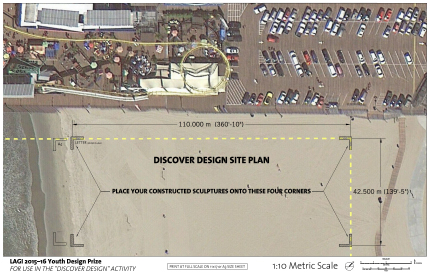
ACTIVITY: Energy Fundamentals + WORKSHEET: Energy Output + PRESENTATION: Renewable Energy Examples
DESCRIPTION
Students learn about how energy is harnessed to create electricity and how it is consumed.
Students study renewable energy technologies in the context of land art generator artworks and learn to estimate the annual output of each installation.
GOALS
Recognize where energy comes from, how it is harnessed, and how it is consumed
Interpret how renewable technologies function
Predict the energy output for different types of technologies
Demonstrate understanding of energy conversion efficiency and capacity factor
ACTIVITY: Imagining Energy
ACTIVITY: LAGI Idea Generator
DESCRIPTION
By playing this game you will begin imagining renewable energy technologies in everyday places—housed in creative forms—and begin to design your own land art generators that could live in your backyard, neighborhood, or city center.
There are five dice categories. Look through example images of each category to get a clear understanding of what each one means. Use all five, or leave one or more categories to your imagination by reducing the number of dice.The dice will answer these five questions:
- What type of place (site) would you like to see your
land art generator in? - What kind of technology will it harness?
- What purpose will it serve to the public (in addition to electricity generation)?
- What form will it take?
- What kind of shapes will it incorporate?
You’ll notice that each category has a Wild Side, which allows you to make something up within the theme of the cube.
This game can be played in groups or individually. If you play in groups, roll your dice once, write down your combination in the worksheet, and pass the dice to the next player!
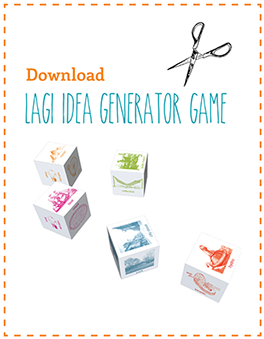
- What type of place (site) would you like to see your
ACTIVITY: Sketching in Context + EXTRA MATERIALS: Design Site Background Drawings
DESCRIPTION
Students begin sketching ideas for a land art generator on the LAGI 2016 Youth Prize design site.
GOALSSketch forms in perspective
Design a public artwork for site-specific context
Reflect on decisions made early in the design process
Sketches of your idea can function as your LAGI Youth Prize submission!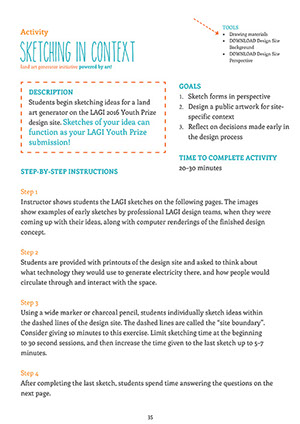
EXAMPLES
Sketching
Look at these examples of sketches (along with their professional computer renderings) by professional LAGI teams.ABOVE are sketches by Trevor Lee of his design for WindNest. The artwork uses horizontal axis wind turbines set in compact acceleration ducts and organic photovoltaic thin film (OPV).
BELOW is his professional computer rendering of WindNest.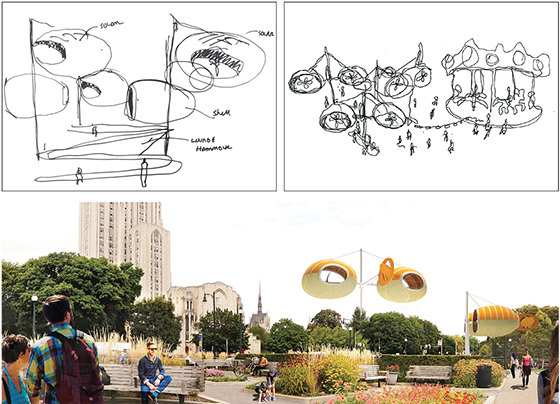
ABOVE is a beautiful illustration of a project titled Tetras by Ann Preston and Roger White. It uses thin film solar panels.
BELOW is a professional computer rendering of Tetras.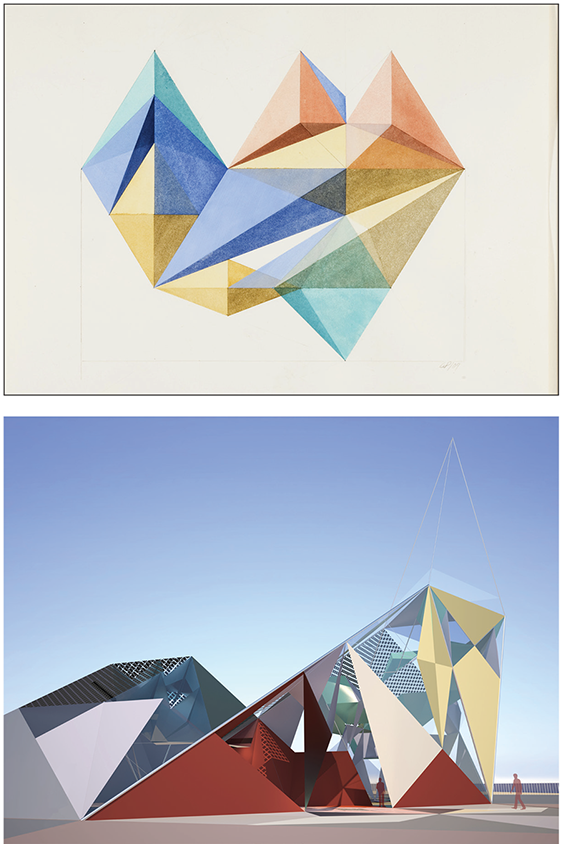
ACTIVITY: Make a Prototype
DESCRIPTION
Students form their design team for the LAGI 2015–16 Youth Design Prize. Together the team sketches their first collaborative design concept, then builds a prototype of their design with models placed on top of the design site plan.
GOALS
Adapt 2D sketches into 3D models
Invent new ways of harnessing clean energy for electricity
Employ understanding of scale in a design context
Demonstrate craft and attention to detail
Photos of your prototype can function as your LAGI Youth Prize submission!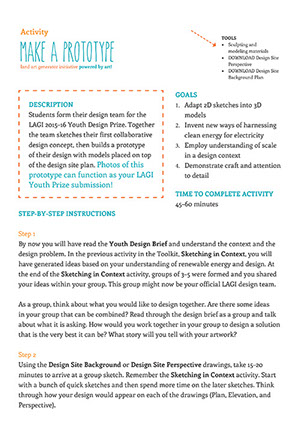
EXAMPLES
Prototypes can be made from anything! Paper, wood, scrap fabric, simple hardware around the house, and found materials, etc. Use your imagination!
Look at these examples of prototypes (along with their professional computer renderings) by professional LAGI teams.ABOVE is Inki Hong, Solim Choi, and Walter Sueldo (Architecture i.S) prototype model of Blossomings. It was made by folding paper!
BELOW are their computer renderings for their LAGI 2012 proposal. The final artwork (images below) is a modular unit that uses a folding geometry to expose solar panels to the sun during the day, and closes at night to become a vertical axis wind turbine.ABOVE are photographs of the prototype made by artist Trevor Lee when designing the WindNest project for a site in Pittsburgh. They are just made out of some simple hardware, wood, and pantyhose!
BELOW is a computer rendering of what it would look like completed. The final artwork has wind turbines inside of the cloud like forms. Each set rotates 360 degrees to face the wind direction at any given time. The orange stripes that you see on top are thin film photovoltaic material.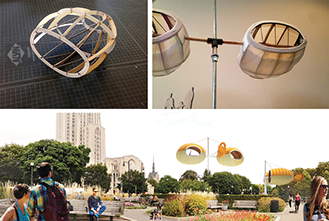
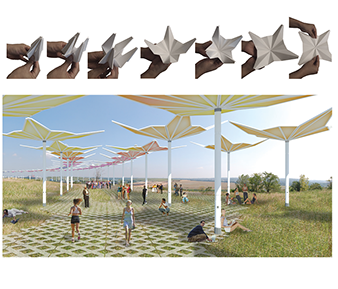
ACTIVITY: LAGI Youth Jury + PRESENTATION: LAGI Jury Example
DESCRIPTION
Students analyze LAGI artworks through a guided exercise. After gaining a deeper understanding of the concepts behind the artworks they are asked to assess each submission based on the LAGI Jury Criteria.
GOALS
Apply visual literacy and analytical skills
Effectively compare and rank designs based on selection criteria
Practice skills in collaboration
ACTIVITY: Good Ideas Get Better
DESCRIPTION
Student teams analyze their designs and seek guidance from others. Through the process, they will learn how to give comments constructively. The format of this activity is similar to a Design Review Meeting that might be conducted with a client on a real project.
GOALS
Evaluate design effectiveness
Consider and propose alternatives
Collaborate with others to improve
Provide feedback to peers in a constructive manner
ACTIVITY: Your Creative Statement
DESCRIPTION
designing their own “land art generators” and create a list of tips for future designers. Students then create their own creative statements, and calculate the energy output of their generators. This is followed by an open work and documentation session.
GOALS
Reflect on the design process
and workshop experience
Articulate aesthetic concepts
Demonstrate a link between language and design
Calculate energy output figures
for generator designs
ACTIVITY: Tell the World
DESCRIPTION
Students learn how to illustrate and graphically present their ideas in a clear and precise manner. The activity includes lessons on hierarchy of information, simplicity of message, and clarity of communication.
GOALS
Apply visual literacy skills
Demonstrate attention to detail
Employ communications skills
Plan and produce design illustrations
GLOSSARY
SUSTAINABLE CITY PLAN: SANTA MONICA
Download this PDF to learn more about the City of Santa Monica's sustainability initiatives.


